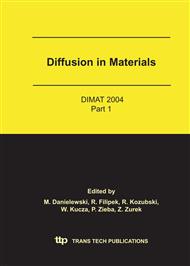p.1264
p.1270
p.1275
p.1281
p.1287
p.1293
p.1299
p.1306
p.1312
3D-Simulation of Void Formation, Growth and Migration under Electromigration
Abstract:
The 3D Monte Carlo scheme is proposed for simulation of simultaneous self-consistent current redistribution, surface diffusion, drift and void migration and coalescence at the interface metal/dielectric. Results of simulation as well as simple phenomenological model demonstrate a possibility of trapping at and migration along the grainboundaries (GBs). Critical size of “detrapping” after coalescence has been estimated.
Info:
Periodical:
Pages:
1306-1311
Citation:
Online since:
April 2005
Authors:
Price:
Сopyright:
© 2005 Trans Tech Publications Ltd. All Rights Reserved
Share:
Citation:


